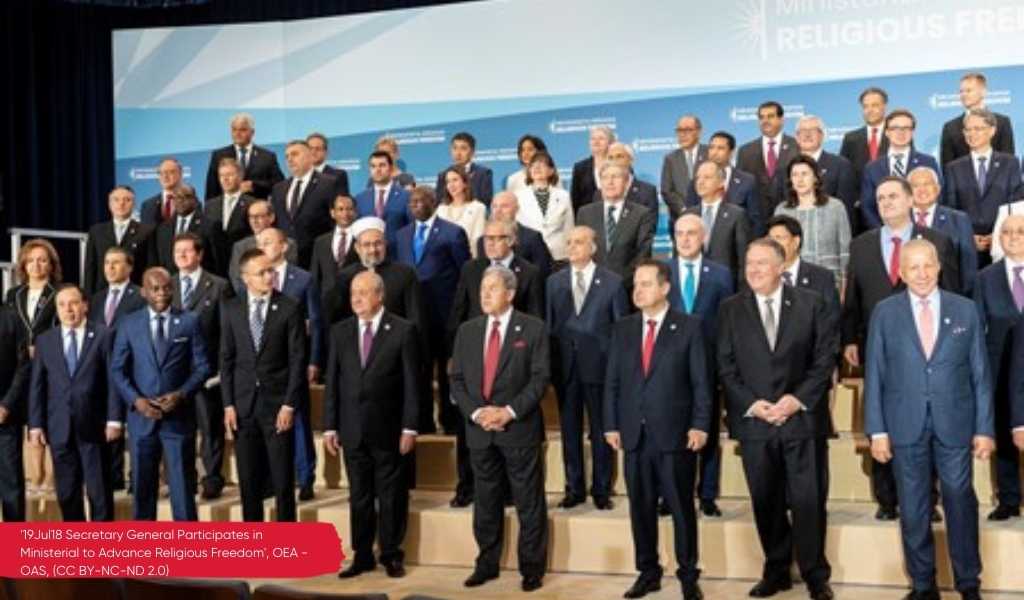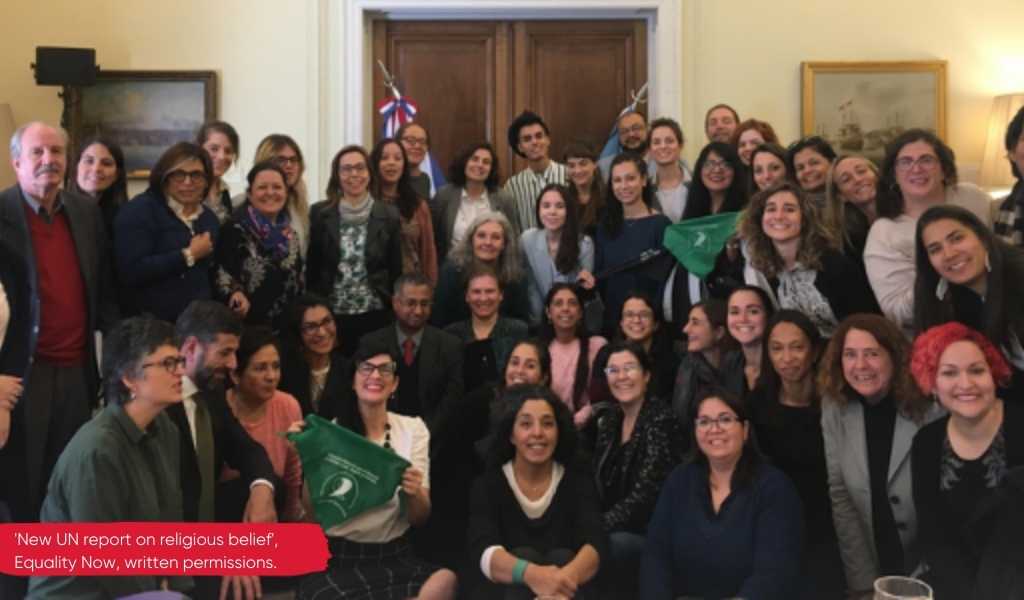What accounts for the invisibility of women in high-level policy spaces on freedom of religion or belief (FoRB)? Here we tell the story through photos. Let’s start with a game: spot the woman in the photo. If a picture can be worth a thousand statistics, then this image below from the Ministerial to Advance Religious Freedom of 2019, one of the most influential spaces created by the US government to champion FoRB, says it all.

While there were many women participating in the Ministerial through the civil society hosted events, when it came to the governmental event, the picture above is in striking contrast to women’s participation in the not so high-level spaces in the same event.
We see the same with the Alliance to advance international religious freedom, another high-level governmental platform that convened for the first time in February 2020 at the Ministry of Foreign Affairs of the Republic of Poland. Instead of ‘spot the woman’ in the photo, we have been inspired by the artistic genius of Alyssa Boni and commitment of Alex Holder to Photoshop out the men to highlight disparity between men and women in positions of power. Through the hard work of James Andrews in cropping and tailing the images, a very interesting photostory emerges.
Have a look at those sitting at the head table with and without women:
Gabriel Piętka/MSZ (CC BY-NC-ND 2.0)
At the same event, we zoomed out of the front table to take a look around the room (Ministry of Foreign Affairs of the Republic of Poland, February 2020). Click on the forward arrow to see what it looked like with and without the men.
The negligible representation of women in these images is not specific to these events. Many other high-level Freedom of Religion or Belief events look very similar. Certainly, millennia-old workings of patriarchy have something to do with it, but usually in operation with other factors, as we will see below.
It doesn’t have to be token women
The argument that we don’t want just token women to fill in the places and spaces is a valid one. But, there is ample expertise out there among both women and men. What is needed is a more concerted effort to identify the women who have been invisible in these platforms but are qualified to participate in them.
I recall in our own Coalition for Religious Equality and Inclusive Development (CREID) programme, when we launched our first event we suddenly found ourselves with several panels that were, in their original conception, all-male. We went back to the drawing board and brainstormed other participants who were excellent fits but had been overlooked because our minds had been attuned to the familiar voices we had grown accustomed to inviting to speak – men.
In the pictures below, we shift the lens to the beautiful Foreign, Commonwealth and Development Office building where an important event was taking place on ‘Building Political Support for UN HRC Resolution 16/18: Tackling religious intolerance and fostering religious freedom and pluralism’.
In the image below the only woman represented in the event in 2013 was Baroness Warsi, one of the most committed spokespersons on religious inclusivity – hardly a token woman by any stretch of the imagination.
For the picture below, we also asked ourselves what would the representation of women look like concerning the other participants if Baroness Warsi was the only one standing?
Building Political Support for UN HRC Resolution 16/18, Foreign, Commonwealth & Development Office (CC BY 2.0).
Promotion of FoRB and interfaith dialogue are not the same
Another reason why high-level platforms on the promotion of religious equality and freedom of religion or belief are sometimes dominated by men is the fact that in some incidences there has been a conflation between the promotion of inter-religious dialogue and the promotion of freedom of religion or belief. The two are not the same. For platforms involving the promotion of inter-religious dialogue, they are often dominated by religious leaders who, not surprisingly, happen to majority men – especially the higher up the hierarchy you go.
However, for the promotion of religious equality or freedom of religion or belief, the expectation is that in addition to religious leaders, there should be a wide array of leaders there – independently of whether they are from within the religious hierarchy or not, and independently of whether they have a professed faith or not.
Religious equality, like gender or racial equality, is for all to claim. Hence a key determinant of the success of FoRB-promoting platforms should be their diversity, not among people of faith, but among all people, across gender, age, ethnicity, geographic origin – the list goes on.
Beyond add women and stir
The issue is not about only making freedom of religion or belief as a theme more gender-sensitive in content (although that is a very welcome step forwards). Ironically, engendering the topic sometimes has the reverse effect of making men’s involvement in FoRB activities suddenly disappear. If the theme of the event is women and freedom of religion or belief or gender and FoRB, the room looks reversed – the majority are women, with only a handful of men. And not surprisingly, this is never the opening theme of a major global summit, often relegated to the margins as a side event or the seminar at the end of the day.
Have a look below at the image in this event associated with the Special Rapporteur on freedom of religion or belief releasing his new report on FoRB and gender:

So, what are we going to do about it?
For our final image on the spaces where freedom of religion or belief are debated we revert to the US, where, in this event, which is not as high-level, more women are included around the table, although as you can detect from the second picture, it’s not quite there in terms of equal representation…
‘IVLP Interfaith Dialogue and Religious Freedom’, Bureau of Educational & Cultural Affairs, (CC BY 2.0).
The aim is not to replace a roomful of men with women or the reverse, but to achieve equity and inclusiveness.
Here are a few practical steps you could take to play your part in pluralising the voices contributing to the promotion of religious equality and freedom of religion or belief:
- Think about including both men and women as keynote speakers
- Consider making panels more gender-equitable in representation
- Refuse to participate in events where women are completely absent and explain to the organisers why
- Share contacts of women leaders, experts, and resource persons around freedom of religion or belief widely with colleagues and if relevant other organisations
- Formulate achievable milestones for ensuring that all public-facing events reflect your commitment to inclusion.
- Think about women in relation to other axes of inequality such as geographic background, profession, age, ability/disability, and ethnicity.
The views presented here are the author’s and do not necessarily represent CREID or the Foreign and Commonwealth Development Office.